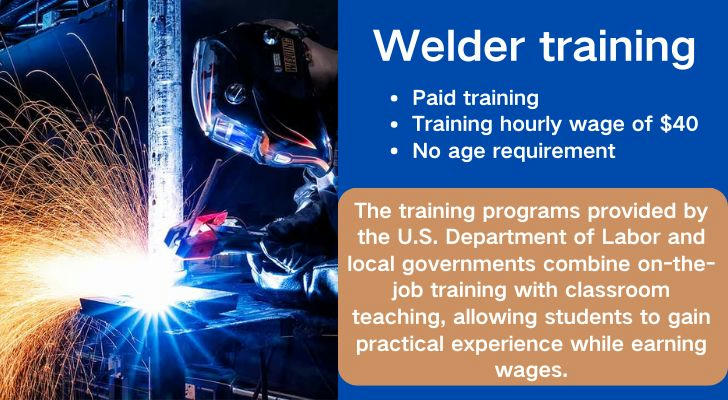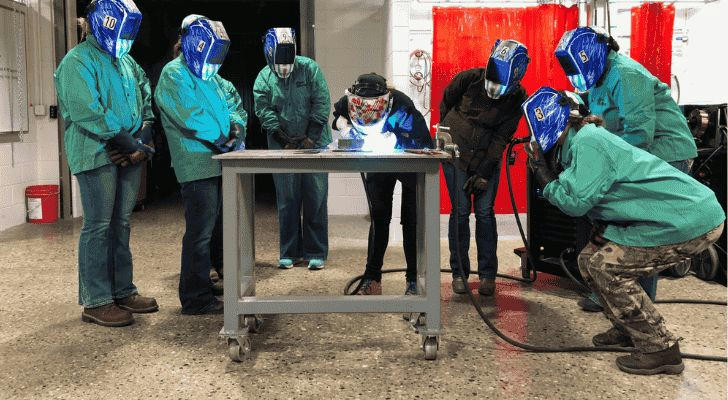Train Now, Earn $40/h—Launch Your Welding Career With Zero Experience
Want to find a stable, high-paying welding job in 2025? The paid training welder program allows you to earn income while learning various welding skills without experience. The hourly salary during training can reach up to $40, and there are also full benefits. The annual salary after graduation is expected to reach $54,000 to $90,000. Regardless of your age, seize this opportunity and start your welding career now!

What apprentices can expect from government-supported paid Welder training
1. Earn While You Learn
Government-supported Welder apprenticeship programs allow you to earn an income while you receive practical training. These programs combine paid on-the-job learning with classroom instruction, allowing you to earn a livable wage from the start—typically starting at $25 per hour and going up to $40 per hour.
2. No Experience Needed – Beginner Friendly
These Welder programs are designed for entry-level learners with no prior experience required. Whether you’re just out of high school, switching careers, or re-entering the workforce, you’ll receive the foundational knowledge and guided mentorship to build your skills from the ground up.
3. Benefits
Medical, dental, full-time 401k or Roth retirement vision insurance
4. Strong Earning Potential After Completion
Earn a Competitive Salary: Skilled welders can expect to earn between $54,000 to $90,000 per year, depending on their experience and location.Salary source. Job growth: Expected to continue rising over the next decade
Certified Welders enjoy not only strong income but also job security across various industries like construction, utilities, and manufacturing.
5. Nationally Recognized Certification & Licensing Support
Upon completion of your training, you’ll be ready to sit for licensing exams such as the Journeyman Welder license, with certifications widely recognized across states. These credentials unlock more job opportunities, better pay, and a clearer pathway to becoming a Master Welder or independent contractor.
6. Flexible Job Options
Welder careers offer a range of flexible work environments and schedules. You can choose from:
Working for construction firms, utilities, or maintenance companies
Becoming a freelance or self-employed Welder
Selecting full-time, part-time, or contract-based work
Specializing in residential, commercial, or industrial electrical systems
7. Real-World Experience From Day One
Students will not be stuck in a classroom with no real-world context. These courses place a strong emphasis on applied training, where students will work with experienced instructors to solve real-world problems in real work environments. This experience will prepare students for employment upon completion of the course.
Who is suitable for government-supported paid Welder training?
Career changers with no experience: No background is needed—training starts with the basics, making it a great fit for restaurant, retail, and other career changers
Hands-on learners: The “earn while you learn” model includes 70% on-sitetraining to quickly acquire skills.
Job stability seekers: Recession-proof industries offer clear advancement opportunities and lifelong career security.
Benefits-focused applicants: Trainees receive health care, retirement plans, and sometimes housing/transportation assistance.
Certification seekers: Programs prepare participants for licensing exams, increasing employability and entrepreneurial potential.

Real-Life Success Stories
- John’s Journey: John, a 32-year-old former truck driver from Pennsylvania, decided to take up welding after participating in a Department of Labor apprenticeship. Within two years, he transitioned into a full-time welding role with General Electric earning a salary of $55,000 per year.
- Maria’s Shift: Maria, a mother of two in her 40s, joined a non-profit welding training program in Texas after being laid off from a retail job. After completing her program, Maria was hired by a local manufacturing plant and now enjoys a stable job with a starting wage of $18 per hour, with the potential for raises as she gains experience.
How to Apply: Step-by-Step Process
1. Research Available Programs: Start by looking into government programs. Alternatively, contact nonprofit organizations, such as the American Welding Society, to learn more about opportunities.
2. Meet Eligibility Requirements: While most programs don’t require prior experience, applicants must meet basic educational and age requirements.
3. Submit Your Application: Submit your application directly to the apprenticeship program or through your local training center. Include your resume, any relevant certifications, and a letter of interest.
4. Interview and Selection: Many programs require an interview or assessment to ensure you are committed and capable of completing the program.
5. Start Training: Once accepted, you will begin your hands-on training with a employer and attend classroom sessions to complement your learning.
7. Conclusion: Take the First Step Toward a Rewarding Career in Welding
Welding is an incredible opportunity for anyone looking to start a new career in 2025. With government-supported and non-profit programs offering paid training, you can develop a sought-after skill while earning an income. Whether you are transitioning careers or just starting out, welding can provide you with stability, job security, and a competitive salary.

For more information, visit the following links:
